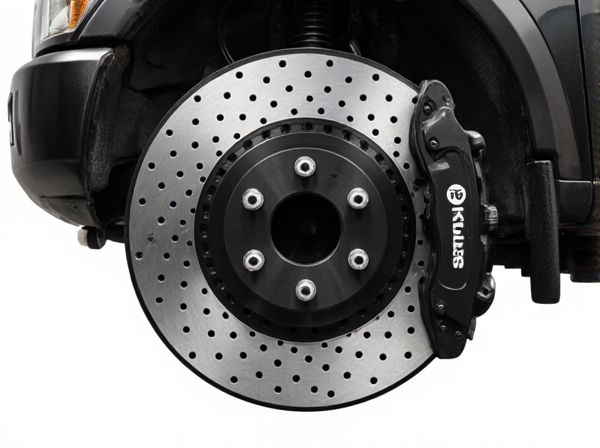
Photo illustration: Cross-Drilled Rotors vs Dimpled Rotors
Cross-drilled rotors feature holes drilled through the surface to improve heat dissipation and reduce brake fade during intense braking. Dimpled rotors have shallow indentations that enhance cooling and maintain structural integrity without compromising strength. Your choice depends on driving style and conditions, with cross-drilled suited for high-performance applications and dimpled rotors offering durability and consistent performance.
Table of Comparison
| Feature | Cross-Drilled Rotors | Dimpled Rotors |
|---|---|---|
| Design | Holes drilled straight through rotor surface | Shallow dimples pressed into rotor surface |
| Heat Dissipation | Improves cooling via direct airflow through holes | Enhances heat dispersion by increasing surface area |
| Brake Pad Wear | Tends to accelerate pad wear due to sharp edges | Causes less pad wear, gentler on brake pads |
| Performance in Wet Conditions | Effective at water evacuation for better braking | Moderate water dispersion, less effective than drilled |
| Structural Integrity | More prone to cracking under extreme stress | Stronger structure, resists cracking better |
| Common Use | High-performance sports and racing vehicles | Street performance and everyday driving |
| Price | Generally higher due to manufacturing complexity | Usually more affordable and durable |
Introduction to Performance Brake Rotors
Cross-drilled rotors feature precision-drilled holes to enhance heat dissipation and reduce brake fade by allowing gases and moisture to escape during high-performance braking. Dimpled rotors, with shallow indentations across the surface, maintain structural integrity while improving heat management and offering consistent braking performance under extreme conditions. Both designs serve performance brake systems by optimizing cooling efficiency and maintaining pad contact, critical for smooth and reliable stopping power.
Cross-Drilled Rotors: Features and Benefits
Cross-drilled rotors feature precision-machined holes that enhance heat dissipation and reduce brake fade during high-performance driving. These rotors improve wet-weather braking by allowing water to escape quickly from the braking surface, maintaining consistent friction. Their lightweight design also contributes to reduced unsprung weight, enhancing vehicle handling and responsiveness.
Dimpled Rotors: Design and Advantages
Dimpled rotors feature precision-engineered indentations that enhance heat dissipation and brake pad grip, improving overall braking performance under extreme conditions. The dimples reduce thermal stress and minimize brake fade by increasing surface area and promoting better gas and dust evacuation. This design offers superior durability and quieter operation compared to traditional drilled rotors, making dimpled rotors ideal for high-performance and daily driving applications.
Heat Dissipation: Cross-Drilled vs Dimpled Rotors
Cross-drilled rotors feature holes drilled through the surface, promoting heat dissipation by allowing hot gases and debris to escape, which reduces thermal buildup during aggressive braking. Dimpled rotors, with shallower indentations, increase surface area and improve cooling efficiency without compromising structural integrity, making them more resistant to cracking under thermal stress. Cross-drilled rotors excel in rapid heat dispersion but can be prone to cracks, whereas dimpled rotors offer a balanced solution for sustained heat dissipation with enhanced durability.
Brake Fade Resistance Comparison
Cross-drilled rotors feature holes drilled through the rotor surface, promoting superior heat dissipation and reducing brake fade during aggressive driving and high-performance applications. Dimpled rotors use shallow indentations that increase surface area, improving ventilation and maintaining consistent brake temperatures under prolonged braking conditions. While cross-drilled rotors excel in rapid cooling, dimpled rotors offer enhanced structural integrity and reduced risk of cracking, making them more durable in resisting brake fade over extended use.
Durability and Crack Resistance
Cross-drilled rotors enhance heat dissipation by allowing gases and debris to escape, but they are more prone to cracking under high thermal stress due to the perforations weakening the structural integrity. Dimpled rotors feature shallow indentations that maintain surface area and structural strength, offering superior durability and greater crack resistance compared to cross-drilled designs. For performance brakes subjected to extreme conditions, dimpled rotors provide a more reliable solution by minimizing the risk of crack formation over time.
Water and Debris Dispersion Capabilities
Cross-drilled rotors feature holes that allow water and debris to escape quickly from the braking surface, enhancing wet-weather performance by reducing hydroplaning and improving pad contact. Dimpled rotors use shallow indentations that increase surface area and disrupt water film, providing consistent dispersion without compromising structural integrity. Both designs effectively improve braking efficiency in adverse conditions, but cross-drilled rotors offer more aggressive water evacuation while dimpled rotors maintain durability under high-stress braking.
Noise and Vibration Considerations
Cross-drilled rotors often generate more noise and vibration due to the presence of drilled holes that can create uneven surfaces and stress concentration points, potentially leading to brake judder. Dimpled rotors, with their shallow indentations instead of full holes, generally provide smoother braking performance by reducing noise and minimizing vibration through improved heat dissipation and consistent contact. Vehicle braking system manufacturers frequently favor dimpled rotors for noise-sensitive applications, balancing performance with driver comfort and reduced brake squeal.
Maintenance and Longevity Aspects
Cross-drilled rotors offer improved heat dissipation and better wet weather performance but are more prone to cracking over time, leading to increased maintenance needs. Dimpled rotors enhance braking efficiency with fewer stress points, resulting in longer rotor lifespan and reduced wear, thereby lowering maintenance frequency. Regular inspections and timely replacement are critical for both types to maximize longevity and maintain optimal braking performance.
Choosing the Right Rotor for Your Driving Needs
Cross-drilled rotors excel in high-performance and track driving by efficiently dissipating heat and gases, reducing brake fade during aggressive braking. Dimpled rotors offer improved brake pad grip and wear resistance, making them ideal for daily driving and moderate spirited use. Choosing the right rotor depends on your driving style, with cross-drilled suited for intense, high-speed conditions and dimpled rotors favoring consistent, reliable braking in everyday scenarios.
 caratoz.com
caratoz.com